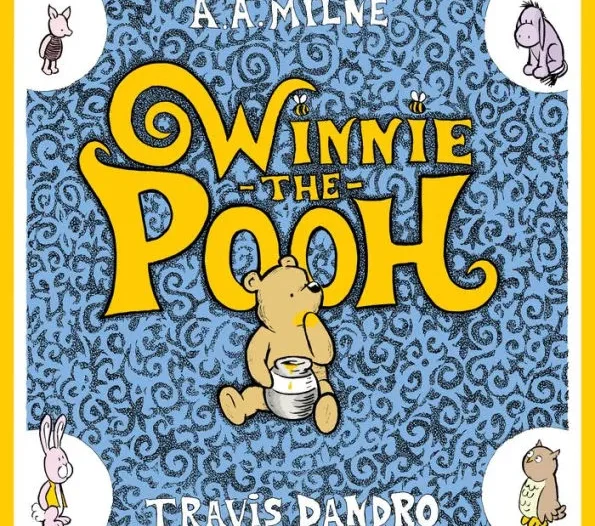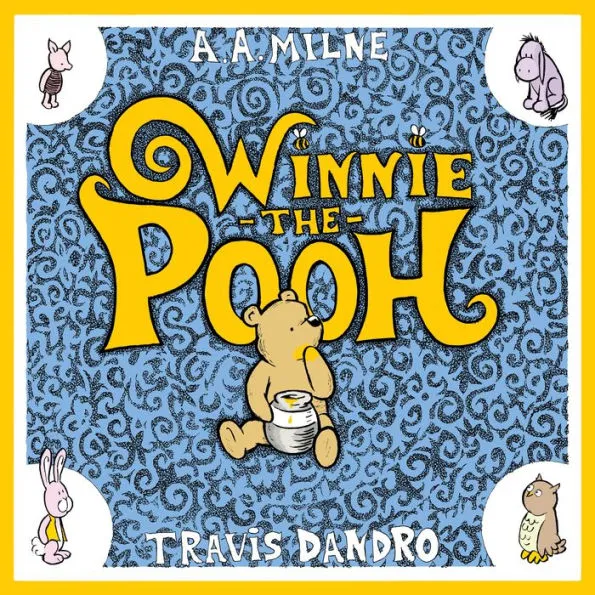
Winnie-The-Pooh | Review

Winnie-The-Pooh
Writer: A.A. Milne
Artist: Travis Dandro
Drawn and Quarterly; $29.95
Publisher’s rating: Age 7 and up
When A.A. Milne’s 1926 nursery classic Winnie-The-Pooh fell into the public domain in 2022, it perhaps became inevitable that there would be a comics adaptation of it at some point. It didn’t have to be as good as cartoonist Travis Dandro’s adaptation of it turns out to be, however, and for that we should be thankful.
Dandro, a cartoonist best known for his 2019 graphic memoir King of King Court, gave himself a daunting assignment in adapting Winnie-The-Pooh in the 21st century, given that two distinct but powerful sets of designs exist for these characters: The original designs by Milne’s artistic collaborator E.H. Shepard and the louder, more expressive cartoon versions introduced by Disney in 1961, after they acquired certain licensing rights from the late Stephen Slesinger. In popular culture, the Disney versions, which saw their first, fullest expression in the 1977 film The Many Adventures of Winnie The Pooh after a series of shorts, have eclipsed Shepard’s cuter, quieter, more stately originals.
ADVERTISEMENT
ADVERTISEMENT
Dandro hews far closer to Shepard’s designs, particularly for the title character himself who, after all, must look somewhat like himself. It can be quite fun for fans of character designs to examine the side-by-sides of the various cast members; Dandro’s Pooh has the basic shape and body of Shepard’s teddy bear-come-to life, but is distinguished by a somewhat blunter snout and bigger nose. Piglet and Eeyore similarly look much like slightly more idiosyncratic versions of Shepard’s designs, again mainly differentiated by bigger, rounder noses, while Rabbit and Owl look completely original, like cartoon versions of the animals drawn from memory, rather than looking at a model (wild or stuffed toy variety). Rabbit sports a checkered vest, the only instance of one of the animals wearing clothes, unless you count Piglet’s striped torso as some sort of onesie.
Finally, Christopher Robin looks far more modern than Shepard’s boy, although there’s a timeless design to the character that befits the classic nature of the book, which could be set in the 1920s…or the 2020s. (Kanga and Roo also appear, but there’s no Tigger; the boisterous stuffed tiger wouldn’t appear until Milne and Shepard’s second book, 1928’s The House at Pooh Corner).
As an adaptation, Dandro’s Winnie-The-Pooh is quite faithful, the notable differences mainly coming down to those that are necessary from adapting one medium to another. Shepard’s art informs Dandro’s, not simply in his design or in its black and white presentation, nor even in Dandro’s line, which isn’t so far removed from Shepard’s. Tonally, they are quite similar, which can be a hard thing to translate across media.
Dandro is a great drawer of trees, of which there are many in the book, and special attention seems to be paid to detailing the golden, natural setting of the gentle adventures. There is certainly a sense of place in the graphic novel that one might not necessarily get from the occasional drawings, as masterful as they may be, of the original illustrated prose book.
Dandro proceeds, story by story, through Winnie-The-Pooh, re-presenting the classic adventures many readers will remember fondly from either the book or its Disney adaptations: Pooh trying to infiltrate the beehive in the high tree by balloon, Pooh getting stuck in Rabbit’s hole, Eeyore losing his tail and so on. They take on a new life in the medium, but one indebted to Milne and Shepard, all without being so reverential of the pair that Dandro’s comic attempts to present itself as a graphic novel collaboration between them.
For an adaptation, then, it’s a highly original work, and a loving tribute to one of the all-time best childhood novels. Is it entirely necessary? Perhaps not. But it’s welcome. If a Winnie-The-Pooh should exist, then this is one that the original work deserves.
Filed under: Reviews
About J. Caleb Mozzocco
J. Caleb Mozzocco has written about comics for online and print venues for a rather long time now. He lives in northeast Ohio, where he works as a circulation clerk at a public library by day.
ADVERTISEMENT
ADVERTISEMENT
SLJ Blog Network
The Shockingly Good Children’s Poetry of 2025
Fifteen early Mock Newbery 2026 Contenders
When Book Bans are a Form of Discrimination, What is the Path to Justice?
Poetry Gateways, a guest post by Amy Brownlee
ADVERTISEMENT







